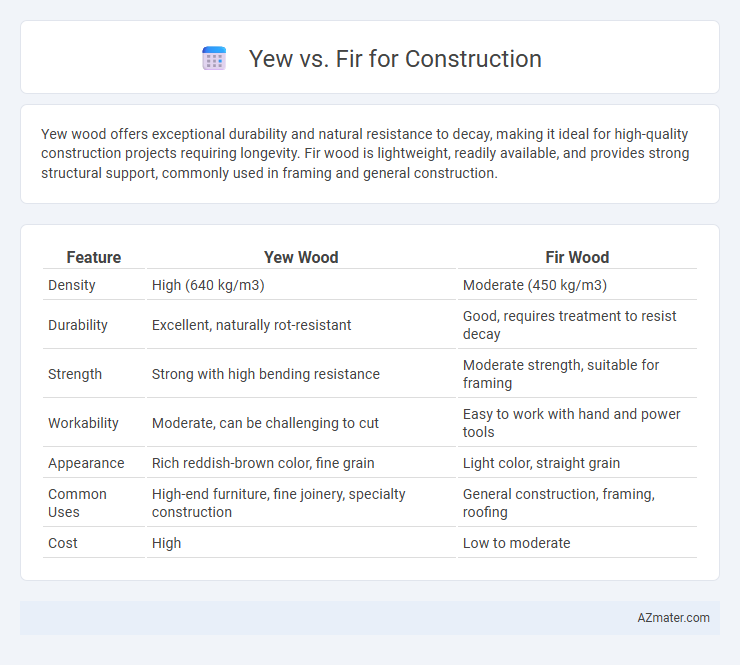Yew wood offers exceptional durability and natural resistance to decay, making it ideal for high-quality construction projects requiring longevity. Fir wood is lightweight, readily available, and provides strong structural support, commonly used in framing and general construction.
Table of Comparison
| Feature | Yew Wood | Fir Wood |
|---|---|---|
| Density | High (640 kg/m3) | Moderate (450 kg/m3) |
| Durability | Excellent, naturally rot-resistant | Good, requires treatment to resist decay |
| Strength | Strong with high bending resistance | Moderate strength, suitable for framing |
| Workability | Moderate, can be challenging to cut | Easy to work with hand and power tools |
| Appearance | Rich reddish-brown color, fine grain | Light color, straight grain |
| Common Uses | High-end furniture, fine joinery, specialty construction | General construction, framing, roofing |
| Cost | High | Low to moderate |
Introduction: Yew and Fir in Construction
Yew wood, prized for its exceptional durability and natural resistance to decay, offers superior strength and fine grain, making it ideal for intricate woodworking and long-lasting structural elements. Fir wood, known for its straight grain and moderate strength, is widely used in construction due to its availability, ease of handling, and cost-effectiveness. Both woods serve distinct roles in construction, with Yew favored for specialized applications requiring longevity and aesthetic appeal, while Fir is commonly chosen for framing and general structural purposes.
Botanical Overview: Yew vs Fir Trees
Yew trees (Taxus species) are coniferous evergreens characterized by dense, dark green needles and red berry-like arils, primarily found in temperate regions of the Northern Hemisphere. Fir trees (Abies species) feature needle-like leaves attached singly to the branch, often softer and flat compared to yew, and produce upright cones that disintegrate to release seeds. Both genera belong to the Pinaceae (fir) and Taxaceae (yew) families respectively, with firs typically growing taller and faster, making fir more prevalent in large-scale construction, while yew's dense, fine-grained wood is prized for detailed woodworking.
Wood Density and Strength Comparison
Yew wood exhibits a density of approximately 630-750 kg/m3, providing moderate strength suited for specialized construction purposes, while fir wood typically ranges from 450-550 kg/m3, making it lighter but less dense. The higher density of yew translates to superior hardness and durability, making it ideal for structural elements requiring resistance to wear and environmental stress. Fir, with its lower density, offers easier workability and faster drying times, favored in framing and general construction where weight reduction is essential.
Durability and Lifespan in Different Climates
Yew wood exhibits exceptional durability and resistance to decay in moist climates, often outperforming fir in terms of lifespan when exposed to variable weather conditions. Fir, while strong and widely used, tends to be less resistant to rot and insect damage, particularly in humid or wet environments, leading to a shorter service life without proper treatment. In colder, drier climates, both yew and fir can maintain structural integrity, but yew's natural oils provide enhanced protection, making it a preferred choice for long-term construction projects.
Workability: Ease of Cutting, Shaping, and Finishing
Yew wood exhibits superior workability due to its fine grain and uniform texture, making it easier to cut, shape, and finish compared to fir. Fir, while softer and lighter, can splinter more easily and requires more careful handling to achieve smooth cuts and finishes. Yew's natural oils also enhance its sanding and polishing properties, providing a refined final surface ideal for detailed carpentry.
Resistance to Pests and Decay
Yew wood offers strong natural resistance to pests and decay due to its dense grain and high resin content, making it suitable for outdoor construction and applications requiring durability. Fir, while commonly used in construction for its strength and availability, is more susceptible to insect damage and decay without chemical treatment. Choosing Yew over Fir can enhance the longevity of structures in environments prone to moisture and pest exposure.
Availability and Sustainability of Yew and Fir
Yew wood is less commonly available than fir, making it a rarer and more expensive option for construction projects. Fir trees grow quickly and are widely cultivated, ensuring a sustainable and abundant supply for timber production. Sustainable forestry practices prioritize fir due to its rapid renewability, while yew's slower growth and limited availability necessitate careful management to avoid depletion.
Cost Comparison: Yew vs Fir Lumber
Yew lumber generally commands a higher price compared to fir due to its rarity and slower growth rate, making it a premium choice for specialized construction projects. Fir, widely available and fast-growing, offers a more cost-effective option suitable for large-scale construction, providing a balance between affordability and strength. Cost efficiency in construction often favors fir, while yew is selected for high-end applications where aesthetics and durability justify the increased expenditure.
Common Construction Uses for Yew and Fir
Yew is primarily used for decorative woodworking, fine furniture, and specialty joinery due to its dense grain, natural durability, and resistance to decay. Fir, especially Douglas fir, is favored in structural framing, flooring, and paneling because of its strength, availability, and ease of handling. Both woods offer unique benefits; Yew excels in detailed finishes while Fir provides robust support in large-scale construction projects.
Conclusion: Which is Better for Your Project?
Yew offers exceptional durability, resistance to decay, and a unique aesthetic with its rich, warm color and fine grain, making it ideal for high-end, decorative construction projects. Fir provides greater structural strength, cost-effectiveness, and ease of workability, making it a preferred choice for framing, beams, and general construction purposes. Choosing between Yew and Fir depends on project requirements, budget, and desired appearance, with Yew suited for premium, visually striking applications and Fir favored for practicality and strength in large-scale construction.

Infographic: Yew vs Fir for Construction
 azmater.com
azmater.com